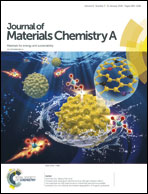Monolithic mesoporous graphitic composites as super capacitors: from Starbons to Starenes®†
Abstract
In this study, we present a new class of monolithic mesoporous carbonaceous materials produced via the carbonisation of a mesoporous starch aerogel highly doped with graphite. Consecutive ball milling, microwave assisted gelation and carbonization treatment produced a high concentration of dispersed graphite. These treatments induce a strong interaction between the graphite particles and the developing carbonaceous matrix, including partial delamination of graphite and the merging of the nanoflakes into the carbonaceous structure. From a combination of SEM and TEM it was found that the graphite particles reduced in size to 24 and 37 nm, matching the pore wall sizes of the produced materials. From XRD, ball milling and heating helped reduce the number of graphene layers by 40%, with presence within the porous starch matrix reducing this a further 13%. The high degree of graphite dispersion/incorporation induces a pronounced increase in conductivity, and excellent capacitance retention, in excess of 10 000 charge–discharge cycles, offering a cost efficient and sustainably produced alternative to activated carbon based EDLCs and importantly, the resultant monolithic structures mitigate the need for additional binders.



 Please wait while we load your content...
Please wait while we load your content...